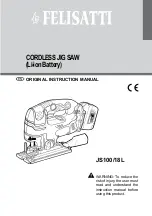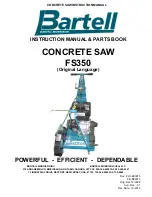
12
4. Thread blade clamping screw (F) into
FIG. 6
D
TIGHTEN
(counterclockwise)
LOOSEN
(clockwise)
saw spindle by hand (screw has left-
hand threads and must be turned
counterclockwise to tighten) (Fig. 6).
5. Depress the blade lock button (D) while
turning the saw spindle with the blade
wrench (L, Fig. 1) until the blade lock
engages and the blade stops rotating.
6. Tighten the blade clamping screw firmly
with the blade wrench.
NOTICE:
Never engage the blade lock while
saw is running, or engage in an effort to
stop the tool. Never turn the saw on while
the blade lock is engaged. Serious damage
to your saw will result.
TO REPLACE THE BLADE
1. To loosen the blade clamping screw (F), depress the blade lock button (D) and
turn the saw spindle with the blade wrench until the blade lock engages and the
blade stops rotating. With the blade lock engaged, turn the blade clamping screw
clockwise with the blade wrench (screw has left-hand threads and must be
turned clockwise to loosen).
2. Remove the blade clamping screw (F) and outer clamp washer (R) only. Remove
old blade.
3. Clean any metal chips/shavings that may have accumulated in the guard or
clamp washer area and check the condition and operation of the lower blade
guard as previously outlined. Do not lubricate this area.
4. Select the proper blade for the application (see
Blades
). Always use blades that
are the correct size (diameter) with the proper size and shape center hole for
mounting on the saw spindle. Always assure that the maximum recommended
speed (rpm) on the saw blade meets or exceeds the speed (rpm) of the saw.
5. Follow steps 2 through 6 under
To Install the Blade
,
making sure that the blade
will rotate in the proper direction.
LOWER BLADE GUARD
WARNING:
Under certain conditions of use, metal chips may become imbedded
in the surfaces of the lower guard, causing the lower guard to rub against the upper
guard. Check the operation of the lower guard before each use and remove any
imbedded chips.
WARNING: The lower blade guard is a safety feature which reduces the risk
of serious personal injury. Never use the saw if the lower guard is missing,
damaged, misassembled or not working properly. Do not rely on the lower blade
guard to protect you under all circumstances. Your safety depends on following
all warnings and precautions as well as proper operation of the saw. Check lower
guard for proper closing before each use as outlined in
Additional Safety Rules for
Circular Saws.
If the lower blade guard is missing or not working properly, have
the saw serviced before using. To assure product safety and reliability, repair,
maintenance and adjustment should be performed by an authorized service center
or other qualified service organization, always using identical replacement parts.
Blades
WARNING:
To minimize the risk of eye injury, always use eye protection. Carbide
is a hard but brittle material. Foreign objects in the workpiece such as wire or nails
can cause tips to crack or break. Only operate saw when proper saw blade guard is in
place. Mount blade securely in proper rotation before using, and always use a clean,
sharp blade.
Blade
Diameter
Teeth
Application
DT1212-QZ
5-1/2" (140 mm)
30
General purpose ferrous metal
cutting
If you need assistance regarding blades, please call 1800 338 002 (Aust) or 0800
339 258 (NZ).
KICKBACK
Kickback is a sudden reaction to a pinched, bound or misaligned saw blade, causing
an uncontrolled saw to lift up and out of the workpiece toward the operator. When the
blade is pinched or bound tightly by the kerf closing down, the blade stalls and the
motor reaction drives the unit rapidly back toward the operator. If the blade becomes
twisted or misaligned in the cut, the teeth at the back edge of the blade can dig into
the top surface of the material causing the blade to climb out of the kerf and jump
back toward the operator.
Summary of Contents for XR Li-Ion DCS373-XE
Page 1: ...DCS373 XE 18V 140 mm 5 1 2 CORDLESS METAL CUTTING CIRCULAR SAW INSTRUCTION MANUAL ...
Page 2: ......
Page 18: ......
Page 19: ......






































